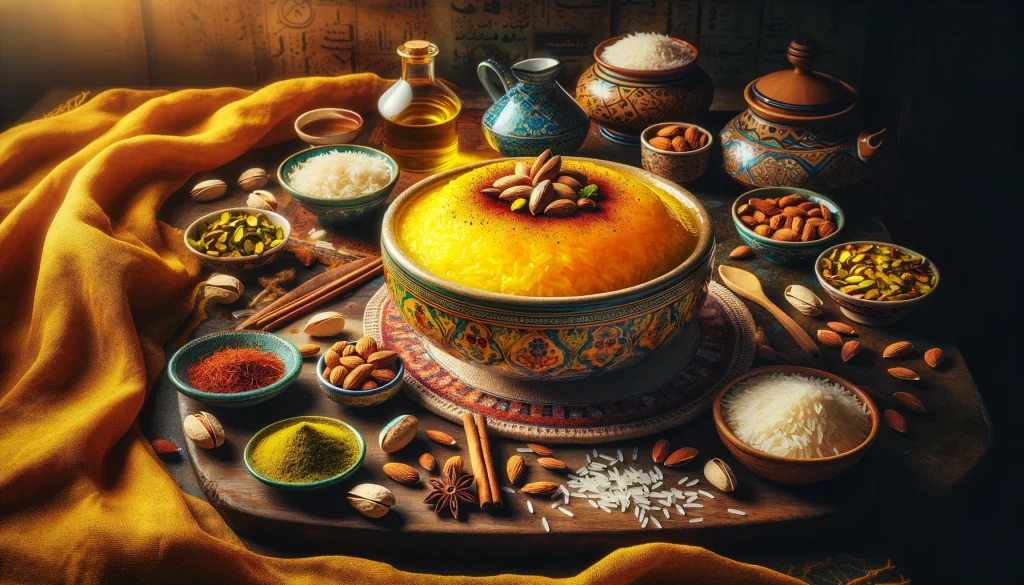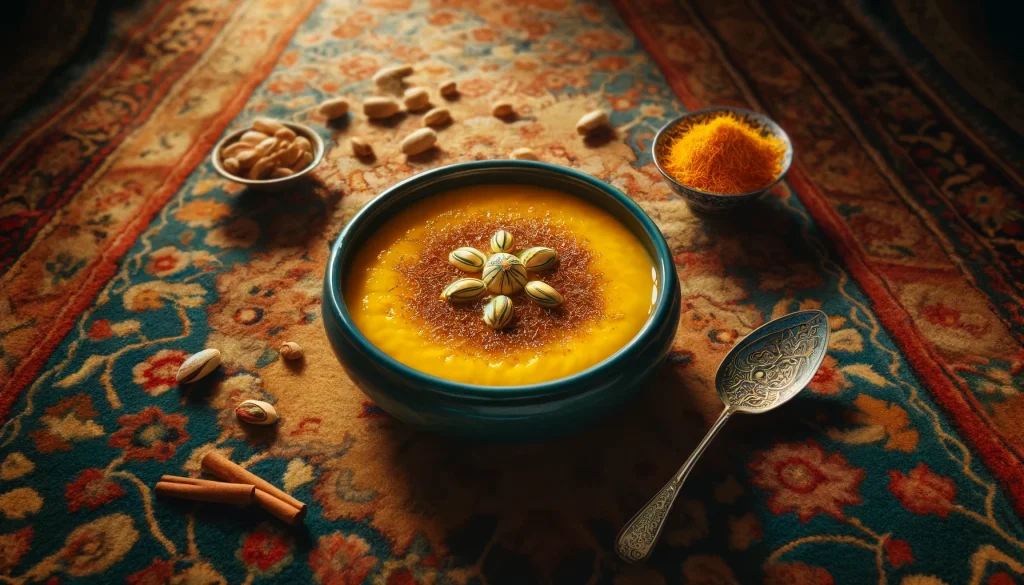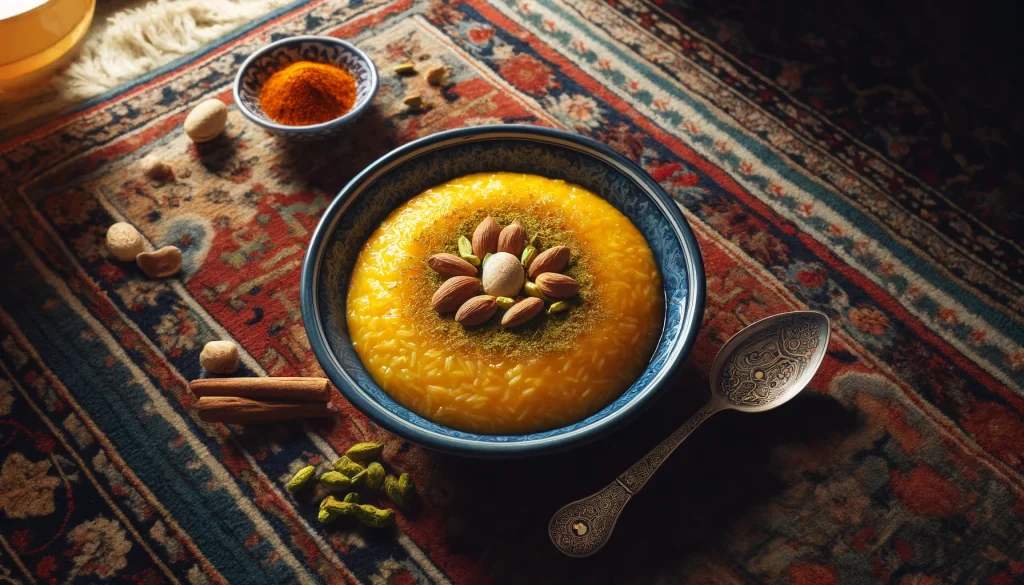As an Amazon Associate I earn from qualifying purchases.
In the rich and aromatic world of Persian cuisine, Sholeh Zard stands out as a testament to the elegance of simplicity in cooking. This traditional saffron rice pudding, known for its vibrant golden hue and exquisite blend of flavors, is a celebration of Iran’s rich culinary heritage. At first glance, Sholeh Zard may seem like a humble rice dessert, but delve a little deeper, and you discover a dish steeped in history and culture. Infused with the luxurious aroma of saffron, the floral essence of rose water, and the warmth of cardamom, each spoonful of Sholeh Zard is a poetic expression of flavor and tradition. As we embark on the journey of preparing this iconic dessert, we not only engage in the simple act of cooking but also partake in a centuries-old tradition that has brought joy and comfort to countless tables. Whether served at festive gatherings or as a soothing end to a family meal, Sholeh Zard is more than just a dessert; it’s a bridge connecting generations through the love of food and shared experiences.
———-
Most Popular
———-
Ingredients
For a traditional Sholeh Zard, sourcing high-quality ingredients is key. Opt for premium saffron for its distinct aroma and color, basmati rice for the perfect texture, and real rose water for an authentic flavor. Fresh almonds and pistachios add crunch and richness. Prioritizing these ingredients elevates your Sholeh Zard, turning it into a memorable dessert.
Where to Buy the Best Ingredients
Pride Of India Long-grain Basmati Rice, 3 lbs Jar : Price on Amazon
Happy Belly White Sugar, 2lb : Price on Amazon
Sadaf Rose Water for Cooking, 20 oz – Ideal for Persian desserts: Price on Amazon
Organic Grass Fed Ghee Butter, 16 Oz – Perfect for Paleo, Keto, Lactose & Gluten Free Diets : Price on Amazon
Naturevibe Cardamom Ground, 1lb : Price on Amazon
…
Sholeh Zard Recipe

Sholeh Zard is a traditional Persian dessert, a fragrant and creamy rice pudding made with basmati rice, water, sugar, and butter. It’s uniquely flavored with rose water and saffron, giving it a distinctive yellow hue and aromatic taste. Slivered almonds add texture, while ground cardamom infuses a subtle spiciness. This pudding is typically garnished with cinnamon and pistachios, enhancing its visual appeal and flavor. Sholeh Zard is usually served cold and is a popular treat during special occasions, celebrated for its rich, sweet, and floral notes.
Sholeh Zard is a traditional Persian rice pudding that’s both aromatic and flavorful. Here’s a recipe to make this delightful dessert:
Ingredients:
- 1 cup long-grain basmati rice
- 1 1/2 liters water
- 2 cups sugar
- 1/4 cup rose water
- 1/2 teaspoon ground saffron dissolved in 2 tablespoons hot water
- 1/4 cup slivered almonds
- 1/4 cup unsalted butter
- 1/2 teaspoon ground cardamom
- Cinnamon and pistachios for garnish
Instructions:
- Rinse the Rice: Rinse the rice under cold running water until the water runs clear.
- Cook the Rice: In a large pot, bring the 1 1/2 liters of water to a boil. Add the rinsed rice and cook on medium heat for about 30 minutes, or until the rice is very soft.
- Add Sugar and Butter: Stir in the sugar and butter. Reduce the heat to low and simmer, stirring occasionally, until the mixture thickens. This may take about 30 minutes.
- Add Flavors: Add the dissolved saffron, rose water, slivered almonds, and ground cardamom to the rice. Stir well.
- Simmer: Continue to simmer on low heat for another 30 minutes, stirring frequently to prevent sticking. The final consistency should be creamy.
- Serve: Pour the Sholeh Zard into a serving dish or individual bowls. Allow it to cool and then refrigerate.
- Garnish: Before serving, garnish with cinnamon, pistachios, and additional slivered almonds if desired.
Sholeh Zard is typically served cold and is known for its distinctive yellow color from saffron and its unique flavor from rose water and cardamom. It’s a festive dish often made for special occasions in Persian cuisine. Enjoy your homemade Sholeh Zard!
TIPS
To make a delightful Sholeh Zard (Persian Saffron Rice Pudding), consider these tips:
- Quality of Saffron: Use high-quality saffron for the best flavor and color. Crush the saffron threads before dissolving in hot water to release more flavor.
- Rice Consistency: The rice should be cooked until it’s very soft and the grains start to break down. This contributes to the creamy texture of the pudding.
- Stirring Regularly: Stir the mixture regularly while it cooks to prevent sticking and burning at the bottom of the pot. This also helps to achieve a smooth, even texture.
- Balancing Sweetness: Adjust the sugar according to your taste. Sholeh Zard is typically sweet, but you can reduce the sugar if you prefer a less sweet dessert.
- Use of Rose Water: Add rose water towards the end of cooking to preserve its delicate flavor. Overcooking can cause the rose water’s aroma to fade.
- Slow Cooking: Cook the mixture on a low flame after adding sugar. Slow cooking allows the flavors to meld together beautifully and the pudding to thicken properly.
- Almond Preparation: If you use whole almonds, blanch and slice them before adding to the pudding. Slivered almonds can be added directly.
- Garnishing: Be generous with the cinnamon, pistachios, and almonds garnish. They not only add to the flavor but also create an attractive presentation.
- Chilling: Sholeh Zard is traditionally served cold. Refrigerate it for several hours before serving to enhance its flavor and texture.
- Serving Dishes: Serve in individual bowls or a large serving dish. Garnish right before serving for the best presentation.
- Consistency Check: The pudding will thicken as it cools. If it’s too thick, you can stir in a little boiled water or milk before serving.
- Leftovers Storage: Store any leftovers in the refrigerator, covered, and consume within a few days.
By following these tips, you’ll be able to create a delicious and authentic Sholeh Zard that’s perfect for any special occasion or as a luxurious treat.
Why This Recipe Is Just So Good…

Sholeh Zard, the Persian saffron rice pudding, is celebrated for several reasons:
- Rich Aromatic Flavors: The combination of saffron, rose water, and cardamom creates a unique and aromatic flavor profile. Saffron imparts a luxurious taste and vibrant color, rose water adds a floral note, and cardamom offers a subtle spiciness.
- Creamy Texture: The slow cooking of rice in water and sugar results in a creamy, velvety texture that is both satisfying and comforting.
- Sweet and Nutty Balance: The sweetness of the pudding is beautifully balanced with the nuttiness of almonds and the earthy flavor of pistachios, creating a delightful taste experience.
- Visual Appeal: The bright yellow hue of saffron and the colorful garnish of cinnamon, pistachios, and almonds make Sholeh Zard not just a treat for the palate but also for the eyes.
- Cultural Significance: As a traditional Persian dish, it carries cultural significance and is often associated with special occasions and celebrations, adding to its charm.
- Versatility: It can be enjoyed as a dessert or a sweet snack, fitting various dietary preferences as it is gluten-free and can be made vegan.
- Comforting Nature: Like many rice puddings, it has a comforting quality that appeals to people of all ages, making it a universal favorite.
- Health Benefits: Saffron, one of the key ingredients, is known for its health benefits, including mood enhancement and potential antioxidant properties.
- Nostalgia: For those with Persian heritage or familiarity with the cuisine, Sholeh Zard often evokes nostalgia and memories of family gatherings and festive celebrations.
- Adaptable Sweetness: The level of sweetness can be adjusted according to personal preference, making it appealing to a wide range of tastes.
Sholeh Zard’s combination of aromatic flavors, creamy texture, and visual beauty, along with its cultural significance, makes it a truly special and delightful dessert.
Storage Instructions
To properly store Sholeh Zard (Persian Saffron Rice Pudding) and maintain its quality, follow these storage instructions:
- Cooling: Allow the Sholeh Zard to cool to room temperature after cooking. Avoid placing it hot or warm directly into the refrigerator as this can cause condensation, affecting its texture.
- Refrigerator Storage: Transfer the cooled Sholeh Zard to an airtight container. This is important to prevent the pudding from absorbing other flavors in the refrigerator and to maintain its freshness.
- Shelf Life: Stored properly in the refrigerator, Sholeh Zard can last for up to 5 days.
- Freezing (Optional): While freezing is not typically recommended for rice puddings due to potential texture changes, you can freeze Sholeh Zard if necessary. Use a freezer-safe airtight container. It can be stored in the freezer for up to 1 month. To use, thaw in the refrigerator and then gently reheat or serve chilled.
- Reheating: If you prefer to enjoy it warm, you can reheat Sholeh Zard in the microwave or on the stovetop. Add a little bit of water or milk to adjust the consistency if it has become too thick.
- Serving After Storage: Before serving, stir the pudding well as separation may occur during storage. You can also add a little fresh garnish to refresh its appearance and flavor.
- Check Before Consuming: Always check for any signs of spoilage, such as an off-smell or mold, before consuming, especially if the pudding has been stored for several days.
Following these storage guidelines will help you enjoy your Sholeh Zard safely and deliciously over the days following its preparation.
Frequently Asked Questions (FAQ’s)

Here are some expert-level questions and answers about Sholeh Zard, the Persian Saffron Rice Pudding:
Q: What type of rice should I use for Sholeh Zard?
A: Basmati rice is ideal for Sholeh Zard due to its fragrance and the way it absorbs flavors. Its long grains also contribute to a pleasing texture.
Q: Can I replace rose water if I don’t have it?
A: Rose water is a key flavor in Sholeh Zard, but if unavailable, you can omit it. There’s no direct substitute, but some people use a few drops of vanilla extract for a different flavor profile.
Q: Why is my Sholeh Zard not yellow?
A: The yellow color comes from saffron. Ensure you’re using enough high-quality saffron and properly dissolving it in hot water to release its color and flavor.
Q: How much saffron should I use?
A: A little saffron goes a long way due to its strong flavor and color. Typically, a pinch of saffron threads (about 1/2 teaspoon) is enough for the standard recipe.
Q: Can I make Sholeh Zard without almonds or pistachios?
A: Yes, you can make it without nuts, although they add a nice texture and flavor. If you’re allergic to nuts or don’t like them, simply omit them.
Q: Is Sholeh Zard served hot or cold?
A: Sholeh Zard is traditionally served cold. After cooking, let it cool and then refrigerate it until it’s chilled.
Q: How long can I store Sholeh Zard?
A: It can be stored in the refrigerator for up to 5 days. Make sure to keep it in an airtight container.
Q: Can Sholeh Zard be frozen?
A: Freezing is not recommended as it can alter the texture. It’s best enjoyed fresh or stored in the refrigerator.
Q: How do I know when Sholeh Zard is cooked?
A: Sholeh Zard is done when the rice is very soft and the mixture has thickened to a creamy pudding consistency. It should not be too runny.
Q: Can I use sugar substitutes in Sholeh Zard?
A: Yes, you can use sugar substitutes like honey or agave syrup, but this will change the traditional flavor. Adjust the amount to achieve the desired sweetness.
Q: What makes saffron a crucial ingredient in Sholeh Zard?
A: Saffron is not only pivotal for imparting the signature golden-yellow hue to Sholeh Zard, but it also provides a distinct floral and earthy aroma and flavor that is characteristic of this dessert. Its quality and quantity directly influence the dish’s color and taste.
Q: Why is basmati rice preferred in this recipe?
A: Basmati rice is preferred for its long, slender grains and its ability to absorb flavors well without becoming mushy. Its fragrant, nutty flavor complements the aromatic ingredients like saffron and rose water used in Sholeh Zard.
Q: Can Sholeh Zard be made vegan?
A: Yes, Sholeh Zard can be made vegan by substituting the butter with a plant-based alternative. The rest of the ingredients are naturally vegan-friendly.
Q: Is there a specific reason for using rose water in the recipe?
A: Rose water adds a distinct floral note to Sholeh Zard, enhancing the fragrance and flavor complexity of the dish. It’s a common ingredient in Persian cuisine, known for its ability to complement saffron’s flavor.
Q: How does the cooking time affect the texture of Sholeh Zard?
A: Proper cooking time is essential for achieving the desired creamy and thick consistency. Overcooking can make the rice too mushy, while undercooking can result in a grainy texture. Consistent stirring and careful heat control are key.
Q: Can other nuts or dried fruits be used as garnishes?
A: While pistachios and almonds are traditional, other nuts like walnuts or dried fruits such as barberries or dried cherries can be used for garnishing, offering different textures and flavors.
Q: Why is cardamom used in the recipe?
A: Cardamom adds a subtle, slightly spicy flavor that complements the sweetness of the dish. It pairs well with saffron and rose water, enhancing the overall taste profile.
Q: What is the importance of stirring the pudding during cooking?
A: Regular stirring prevents the rice from sticking to the bottom of the pot and ensures even cooking and texture. It also helps to break down the rice grains, contributing to the creaminess of the pudding.
Q: How can the consistency of Sholeh Zard be adjusted?
A: The consistency can be adjusted by varying the amount of water used and the cooking time. For a thicker pudding, cook it longer and use less water. For a thinner consistency, add more water and reduce the cooking time slightly.
Q: How can the flavor of Sholeh Zard be intensified?
A: To intensify the flavor, use high-quality saffron and rose water, and ensure proper infusion of these ingredients. Additionally, allowing the pudding to rest and cool can help the flavors meld together more effectively.
These expert insights offer a deeper understanding of the nuances in preparing Sholeh Zard and how each ingredient and step contributes to the final flavor and texture of this traditional Persian dessert.
Conclusion
As we conclude our exploration of the delightful Sholeh Zard, we are reminded of the power of traditional recipes to transcend time and borders, bringing a piece of history and culture to our modern tables. This Persian saffron rice pudding, with its rich tapestry of flavors and vibrant golden hue, is more than just a testament to the art of Persian cuisine; it’s a symbol of the universal language of food that connects us all. The combination of aromatic saffron, soothing rose water, and warm cardamom, complemented by the textures of rice, almonds, and pistachios, creates not just a dish, but an experience that delights the senses.
Sholeh Zard, in its simplicity and depth, embodies the essence of culinary heritage — a heritage that is lovingly passed down through generations, telling stories of family gatherings, festive celebrations, and the everyday joy of sharing a meal. As you savor each spoonful, let it transport you to ancient Persia, where such recipes were not just about nourishment but also about art, culture, and community.
In the end, Sholeh Zard is more than just a recipe; it’s a journey through flavors and time, an invitation to explore the rich tapestry of Persian cuisine, and a reminder of the enduring legacy of traditional cooking. Whether enjoyed as a dessert, a comfort food, or a sweet link to heritage, Sholeh Zard continues to be a cherished dish, savored by food enthusiasts around the world and standing as a proud testament to the timeless beauty of Persian culinary traditions.






